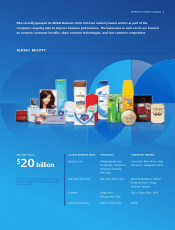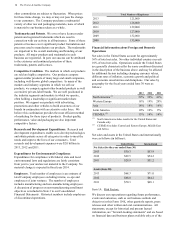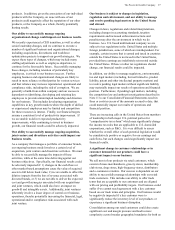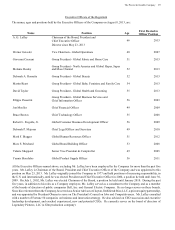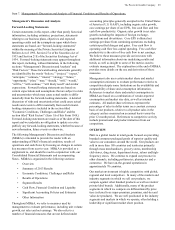Proctor and Gamble 2013 Annual Report Download - page 17
Download and view the complete annual report
Please find page 17 of the 2013 Proctor and Gamble annual report below. You can navigate through the pages in the report by either clicking on the pages listed below, or by using the keyword search tool below to find specific information within the annual report.The Procter & Gamble Company 15
time the statements are made, which may become out of date
or incomplete. We assume no obligation to update any
forward-looking statements as a result of new information,
future events, or other factors. Forward-looking statements
are inherently uncertain and investors must recognize that
events could significantly differ from our expectations.
The following discussion of “risk factors” identifies the most
significant factors that may adversely affect our business,
operations, financial position or future financial
performance. This information should be read in
conjunction with MD&A and the Consolidated Financial
Statements and related Notes incorporated in this report.
The following discussion of risks is not all inclusive, but is
designed to highlight what we believe are important factors
to consider when evaluating our expectations. These factors
could cause our future results to differ from those in the
forward-looking statements and from historical trends.
A change in consumer demand for our products and/or
lack of market growth could have a significant impact on
our business.
We are a consumer products company and rely on continued
global demand for our brands and products. To achieve
business goals, we must develop and sell products that
appeal to consumers. This is dependent on a number of
factors, including our ability to develop effective sales,
advertising and marketing programs. We expect to achieve
our financial targets, in part, by focusing on the most
profitable businesses, biggest innovations and most
important emerging markets. We also expect to achieve our
financial targets, in part, by achieving disproportionate
growth in developing regions. If demand for our products
and/or market growth rates in either developed or developing
markets falls substantially below expected levels or our
market share declines significantly in these businesses, our
volume, and consequently our results, could be negatively
impacted. This could occur due to, among other things,
unforeseen negative economic or political events, changes in
consumer trends and habits or negative consumer responses
to pricing actions.
The ability to achieve our business objectives is
dependent on how well we can compete with our local
and global competitors in new and existing markets and
channels.
The consumer products industry is highly competitive.
Across all of our categories, we compete against a wide
variety of global and local competitors. As a result, there are
ongoing competitive pressures in the environments in which
we operate, as well as challenges in maintaining profit
margins. This includes, among other things, increasing
competition from mid- and lower-tier value products in both
developed and developing markets. To address these
challenges, we must be able to successfully respond to
competitive factors, including pricing, promotional
incentives and trade terms. In addition, the emergence of
new sales channels may affect customer and consumer
preferences, as well as market dynamics. Failure to
effectively compete in these new channels could negatively
impact results.
Our ability to meet our growth targets depends on
successful product, marketing and operations innovation
and our ability to successfully respond to competitive
innovation.
Achieving our business results depends, in part, on the
successful development, introduction and marketing of new
products and improvements to our equipment and
manufacturing processes. Successful innovation depends on
our ability to correctly anticipate customer and consumer
acceptance, to obtain and maintain necessary intellectual
property protections and to avoid infringing the intellectual
property rights of others. We must also be able to
successfully respond to technological advances made by
competitors and intellectual property rights granted to
competitors. Failure to do so could compromise our
competitive position and impact our results.
Our businesses face cost fluctuations and pressures that
could affect our business results.
Our costs are subject to fluctuations, particularly due to
changes in commodity prices, raw materials, labor costs,
energy costs, pension and healthcare costs and foreign
exchange and interest rates. Therefore, our success is
dependent, in part, on our continued ability to manage these
fluctuations through pricing actions, cost saving projects and
sourcing decisions, while maintaining and improving
margins and market share. In addition, our financial
projections include cost savings described in our announced
productivity plan. Failure to deliver these savings could
adversely impact our results.
We face risks that are inherent in global manufacturing
that could negatively impact our business results.
We need to maintain key manufacturing and supply
arrangements, including any key sole supplier and sole
manufacturing plant arrangements, to achieve our cost
targets. While we have business continuity and contingency
plans for key manufacturing sites and the supply of raw
materials, it may be impracticable to have a sufficient
alternative source, particularly when the input materials are
in limited supply. In addition, our strategy for global growth
includes increased presence in emerging markets. Some
emerging markets have greater political volatility and greater
vulnerability to infrastructure and labor disruptions than
established markets. Any significant disruption of
manufacturing, such as labor disputes, loss or impairment of
key manufacturing sites, natural disasters, acts of war or
terrorism and other external factors over which we have no
control, could interrupt product supply and, if not remedied,
have an adverse impact on our business.


